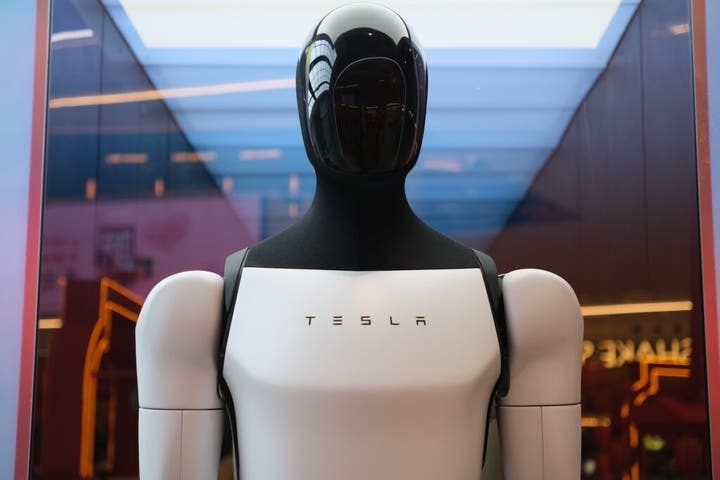Benzinga and Yahoo Finance LLC may earn commission or revenue on some items through the links below.
Tesla Inc (NASDAQ:TSLA) is about to rubber-stamp one of the most extravagant CEO pay packages in corporate history — a $1 trillion, 10-year deal for Elon Musk — even as its valuation stretches further from reality.
Musk’s compensation includes $31 billion in restricted stock and could soar past $113 billion in total. It also comes at a time when the car company’s market share is shrinking.
That’d be bad enough if it weren’t just a car company trying to be something else. Its Optimus robot projects, for example, are stalling. And those long-promised robotaxis? They remain years behind rivals like Alphabet Inc‘s (NASDAQ:GOOG) Waymo, Uber Technologies Inc (NYSE:UBER) and Amazon.com Inc.‘s (NASDAQ:AMZN) subsidiary Zoox.
Indeed, the chorus of boos is loud ahead of the company’s third-quarter earnings, which are to be announced on Wednesday. Still, Musk has plenty of like-minded business people cheering on his wild salary bump.
Trending: Amazon and NVIDIA Partnered With This Robot Chef — Now Individual Investors Can Too
International Shareholder Services (ISS) opposes Musk’s pay package, citing “unmitigated concerns surrounding the special award’s magnitude and design.”
If approved, the plan would become the most extensive CEO compensation package ever granted by a public company. It could potentially increase Musk’s stake in Tesla by 12% if the automaker reaches a market capitalization of $8.5 trillion in 10 years.
But here’s the thing: Under Musk, Tesla experienced a decline in its global market share, which has dropped from about 23% to 18% over the past year. Its market capitalization remains strong at $1.4 trillion, though its stock price has faced significant volatility.
ARK Invests‘ CEO Cathie Wood isn’t worried. She even criticized the ISS’s recommendation to vote against the pay package.
“Isn’t it sad, if not damning, that institutional shareholders rely on proxy firms to tell them how they should vote? Index funds do no fundamental research, yet dominate institutional voting,” Wood said, calling index-based investing a “form of socialism.”
The automaker’s $8 trillion market cap dream hinges on a narrative that Tesla is no longer just a car company but a futuristic AI powerhouse.
“After a brutal few quarters we are finally starting to see stable demand trends for Tesla,” Wedbush analyst Dan Ives recently wrote. “The Tesla story going forward is around the AI transformation being led by the autonomous and robotics initiatives.”
That narrative is fraying fast.
The Optimus robot project is on pause. Milan Kovac, the head of engineering for Optimus, resigned in June, and a separate Optimus AI lead, Ashish Kumar, left the company in September to join Meta Platforms Inc (NASDAQ:META).
Tesla is now pinning its hopes on a merger with Musk’s other PR-nightmare of a company, xAI.
Whether Tesla can wield M&A to capture market share from its competition is not yet clear. Most mergers and acquisitions (M&A) transactions tend to fail in the long term.
See Also: Missed Nvidia and Tesla? RAD Intel Could Be the Next AI Powerhouse — Invest Now at Just $0.81 a Share
The deal won the endorsement of at least one other billionaire: Chamath Palihapitiya. The Social Capital founder even suggested including Musk’s other venture, SpaceX, in a three-way.
“I’m here for it,” Palihapitiya, a Musk admirer, said.
Musk’s rivals, meanwhile, are accelerating: BYD Co. Ltd. (OTC:BYDDY) (OTC:BYDDF) is selling EVs for a fifth of Tesla’s price. And Waymo’s autonomous vehicle (AV) fleet is already on the streets, slated to launch in London in 2026.
As NYU professor Scott Galloway quipped on a recent podcast, Musk is “the David Copperfield of the modern economy” — and the magic may be fading.
If Tesla deserves a trillion-plus valuation for lagging in autonomy, then Google, which owns Waymo, should be worth an extra trillion itself, Galloway’s co-host, Ed Elson, added.
Divisiveness within the Trump administration, which had an acrimonious breakup with Musk, could exacerbate Tesla’s challenges. The elimination of EV tax credits keeps the cars expensive. Recall how the company hyped up the lower-priced Model 3 Standard and Model Y Standard. Yes, it comes with fewer features than the traditional models, and the vehicles have cheaper price points than Tesla’s main vehicles.
However, with the expiration of the federal EV tax credit, consumers are actually paying more for models with fewer features than they would have paid for the regular version before the tax credits were eliminated.
The robotaxi segment is also in trouble. Trump’s NHTSA administrator nominee, Jonathan Morisson, has advocated for stricter oversight of self-driving vehicles, potentially clashing with Duffy’s approach. Meanwhile, Senator Josh Hawley (R-MO) plans to introduce legislation that would effectively ban fully autonomous driving, calling such vehicles “terrible for working people.”
On the other hand, Tesla’s expansion aligns with Transportation Secretary Sean Duffy‘s announcement that the NHTSA will relax autonomous driving regulations, a move that bolsters Tesla’s robotaxi ambitions as federal standards evolve.
“The rules of the road need to be updated to fit the realities of the 21st century,” Duffy said.
Ironically, Musk doesn’t seem to like Duffy, calling him a “Dummy” when it comes to NASA.
“The person responsible for America’s space program can’t have a 2-digit IQ,” Musk said.
Image: Shutterstock
Trending Now:
Building a resilient portfolio means thinking beyond a single asset or market trend. Economic cycles shift, sectors rise and fall, and no one investment performs well in every environment. That’s why many investors look to diversify with platforms that provide access to real estate, fixed-income opportunities, professional financial guidance, precious metals, and even self-directed retirement accounts. By spreading exposure across multiple asset classes, it becomes easier to manage risk, capture steady returns, and create long-term wealth that isn’t tied to the fortunes of just one company or industry.
Backed by Jeff Bezos, Arrived Homes makes real estate investing accessible with a low barrier to entry. Investors can buy fractional shares of single-family rentals and vacation homes starting with as little as $100. This allows everyday investors to diversify into real estate, collect rental income, and build long-term wealth without needing to manage properties directly.
Vinovest lets investors diversify into fine wine — a historically stable, low-volatility asset class that has outperformed the S&P 500 over multiple decades. With professionally managed portfolios, secure storage, and insurance included, users can invest in wine without needing to be experts themselves. Minimums start at $1,000, and investors retain full ownership of their wine, which has the potential to appreciate in value as global demand grows.
For those seeking fixed-income style returns without Wall Street complexity, Worthy Property Bonds offers SEC-qualified, interest-bearing bonds starting at just $10. Investors earn a fixed 7% annual return, with funds deployed to small U.S. businesses. The bonds are fully liquid, meaning you can cash out anytime, making them attractive for conservative investors looking for steady, passive income.
Self-directed investors looking to take greater control of their retirement savings may consider IRA Financial. The platform enables you to use a self-directed IRA or Solo 401(k) to invest in alternative assets such as real estate, private equity, or even crypto. This flexibility empowers retirement savers to go beyond traditional stocks and bonds, building diversified portfolios that align with their long-term wealth strategies.
Moomoo isn’t just for trading — it’s also one of the most attractive places to park cash. New users can earn a promotional 8.1% APY on uninvested cash, combining a 3.85% base rate with a 4.25% booster once activated. On top of that, eligible new users can also score up to $1,000 in free Nvidia stock—but the real draw here is the ability to earn bank-beating interest rates without having to move into riskier assets.
SoFi gives members access to a wide range of professionally managed alternative funds, covering everything from commodities and private credit to venture capital, hedge funds, and real estate. These funds can provide broader diversification, help smooth out portfolio volatility, and potentially boost total returns over time. Many of the funds have relatively low minimums, making alternative investing accessible.
Range Wealth Management takes a modern, subscription-based approach to financial planning. Instead of charging asset-based fees, the platform offers flat-fee tiers that provide unlimited access to fiduciary advisors along with AI-powered planning tools. Investors can link their accounts without moving assets, while higher-level plans unlock advanced support for taxes, real estate, and multi-generational wealth strategies. This model makes Range especially appealing to high-earning professionals who want holistic advice and predictable pricing.
For investors concerned about inflation or seeking portfolio protection, American Hartford Gold provides a simple way to buy and hold physical gold and silver within an IRA or direct delivery. With a minimum investment of $10,000, the platform caters to those looking to preserve wealth through precious metals while maintaining the option to diversify retirement accounts. It’s a favored choice for conservative investors who want tangible assets that historically hold value during uncertain markets.
This article Tesla’s $1 Trillion Illusion: Elon Musk’s Pay Package And The Robotaxi Myth originally appeared on Benzinga.com


